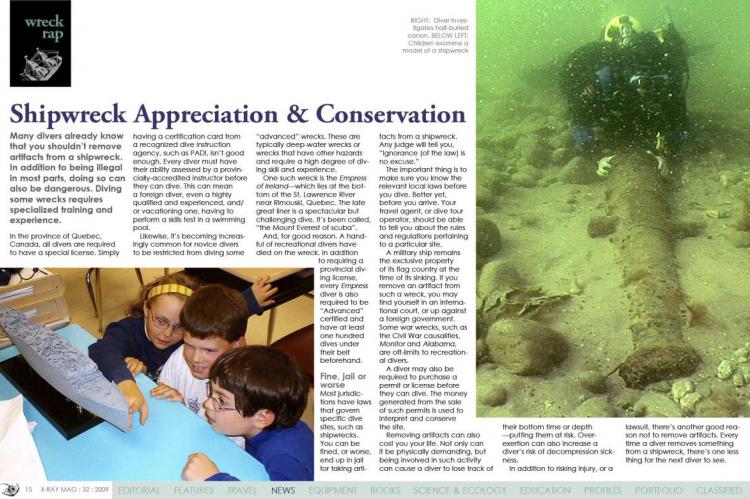Shipwreck Appreciation & Conservation
Many divers already know that you shouldn’t remove artifacts from a shipwreck. In addition to being illegal in most parts, doing so can also be dangerous.
Tags & Taxonomy
Every diver must have their ability assessed by a provincially-accredited instructor before they can dive. This can mean a foreign diver, even a highly qualified and experienced, and/or vacationing one, having to perform a skills test in a swimming pool.
Likewise, it’s becoming increasingly common for novice divers to be restricted from diving some “advanced” wrecks. These are typically deep-water wrecks or wrecks that have other hazards and require a high degree of diving skill and experience.
One such wreck is the Empress of Ireland—which lies at the bottom of the St. Lawrence River near Rimouski, Quebec. The late great liner is a spectacular but challenging dive. It’s been called, “the Mount Everest of scuba”.
And, for good reason. A handful of recreational divers have died on the wreck. In addition to requiring a provincial diving license, every Empress diver is also required to be “Advanced” certified and have at least one hundred dives under their belt beforehand.
Fine, jail or worse
Most jurisdictions have laws that govern specific dive sites, such as shipwrecks. You can be fined, or worse, end up in jail for taking artifacts from a shipwreck. Any judge will tell you, “Ignorance (of the law) is no excuse.”
The important thing is to make sure you know the relevant local laws before you dive. Better yet, before you arrive. Your travel agent, or dive tour operator, should be able to tell you about the rules and regulations pertaining to a particular site.
A military ship remains the exclusive property of its flag country at the time of its sinking. If you remove an artifact from such a wreck, you may find yourself in an international court, or up against a foreign government. Some war wrecks, such as the Civil War causalities, Monitor and Alabama, are off-limits to recreational divers.
A diver may also be required to purchase a permit or license before they can dive. The money generated from the sale of such permits is used to interpret and conserve the site.
Removing artifacts can also cost you your life. Not only can it be physically demanding, but being involved in such activity can cause a diver to lose track of their bottom time or depth
—putting them at risk. Over-exertion can also increase a diver’s risk of decompression sickness.
In addition to risking injury, or a lawsuit, there’s another good reason not to remove artifacts. Every time a diver removes something from a shipwreck, there’s one less thing for the next diver to see.
Not politically correct
In the old days, taking artifacts demonstrated a diver’s prowess. If a ship’s bell or bridge gear was there, it meant you were the first to dive the wreck. So, you took it. But, like lots of other former past-times, such as big game hunting and scalping Indians, taking artifacts from shipwrecks is no longer socially acceptable.
Once an artifact is removed from the water, it quickly deteriorates. If you remove something and it’s not properly conserved, it will likely turn into a pile of rust. And, when you take an artifact, you reduce the historical and archaeological significance of the wreck that it came from.
I can’t tell you the number of times I’ve returned to a shipwreck to find that artifacts have been removed—often illegally. And, sometimes in their pursuit of artifacts divers have destroyed parts of the ship. Surveying the damage, you feel violated. If you’ve ever had your house or apartment robbed you’ll know what I’m talking about. But, what’s most frustrating is knowing that most divers were acting out of ignorance.
Likewise, it’s equally frustrating when you’re taking divers on a tour of a wreck to find that artifacts have been removed. You’ve told them about what they can expect to see on the dive. When it’s not there, they feel cheated, and you feel foolish.
Wreck diving can lead a diver into areas of academic research and study. I know lots of divers who would, otherwise, never have found their local public library. Researching shipwrecks can be a rewarding activity in itself. A friend of mine calls it, “his drug of choice”.
The old adage, “take only pictures and leave only bubbles”, is still the best approach when it comes to appreciating and conserving shipwreck artifacts. And, it’s a good way to meet other divers, hone your skills and stay interested in diving. ■
—‑Rob Rondeau
Marine Archaeologist
ProCom Diving Services
www.procomdiving.com
Download the full article ⬇︎

Originally published
X-Ray Mag #32
Sabah special - Reefs & Rainforests :: Pulau Lankayan - Sugud Islands Marine Conservation Area - Sepilok Orangutans - Kinabatangan River - Danum Valley Conservation Area - Sipadan, Mabul & Kapalai - Interview with Clement Lee :: Kids Love to Dive :: Archaeology; Underwater settlements explored in the Yucatán jungle :: Axis Mundi, the making of a film :: Drysuits; What to purchase and taking a look at the recent models and latest trends :: Photography; Tony White explains how he took that macroshot :: Review of the Poseidon/CIS-Lunar Disvcovery Closed Circuit Rebreather :: Dreamy underwater world of American artist, Jude Cowell


































